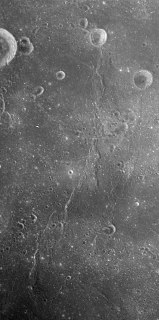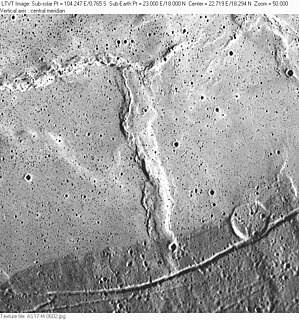
Letronne is the lava-flooded remnant of a lunar impact crater. It was named after French archaeologist Jean-Antoine Letronne. The northern part of the rim is completely missing, and opens into the Oceanus Procellarum, forming a bay along the southwestern shore. The formation is located to the northwest of the large crater Gassendi.To the west-southwest is the flooded crater Billy, and north-northwest lies the smaller Flamsteed.

In geology, the places known as hotspots or hot spots are volcanic regions thought to be fed by underlying mantle that is anomalously hot compared with the surrounding mantle. Their position on the Earth's surface is independent of tectonic plate boundaries. There are two hypotheses that attempt to explain their origins. One suggests that hotspots are due to mantle plumes that rise as thermal diapirs from the core–mantle boundary. The other hypothesis is that lithospheric extension permits the passive rising of melt from shallow depths. This hypothesis considers the term "hotspot" to be a misnomer, asserting that the mantle source beneath them is, in fact, not anomalously hot at all. Well-known examples include the Hawaii, Iceland and Yellowstone hotspots.
William Walden Rubey was an American geologist.
Dorsa Aldrovandi is a wrinkle ridge system at 23.6°N 28.7°E in Mare Serenitatis on the Moon. It is about 127 km long and was named after the 16th century Italian naturalist Ulisse Aldrovandi. The north end of the feature is at the crater Le Monnier, and the south end is close to the craters Clerke and Abetti.

Dorsa Andrusov is a wrinkle ridge system at 1.0°S 57.0°E in Mare Fecunditatis on the Moon. It is 160 km in diameter and was named after Soviet geologist Nicolai Ivanovich Andrusov in 1976 by the IAU.

Dorsa Barlow is a wrinkle ridge system on the Moon, in Mare Tranquilitatis near the border with Mare Serenitatis, centered at 14.0°N 30.6°E. It is about 110 km long and was named after British crystallographer William Barlow in 1976.

Dorsa Smirnov is a wrinkle ridge system at 27.3°N 25.3°E in eastern Mare Serenitatis on the Moon. It is 222 km long and was named after Soviet geologist Sergei Sergeevich Smirnov by the IAU in 1976.

Dorsa Burnet are wrinkle ridges at 28.4°N 57.0°W in Oceanus Procellarum on the Moon. They are about 194 km long and were named after Thomas Burnet by the IAU in 1976.

Dorsa Cato is a wrinkle ridge at 1.0°N 47.0°E on the Moon. It is approximately 130 km long and was named after Roman geological engineer Cato the Elder in 1976 by the IAU.
Dorsa Dana is a wrinkle ridge at 3.0°N 90.0°E in Mare Smythii on the Moon. It is 82 km long and was named after American geologist James Dwight Dana in 1976.

Dorsa Ewing is a wrinkle ridge at 10.2°S 39.4°W in Oceanus Procellarum on the Moon. It is 262 km long and was named after American geophysicist William Maurice Ewing.
Dorsa Harker is a wrinkle ridge at 14.5°N 64.0°E in Mare Crisium on the Moon. It is 213 km long and was named after Alfred Harker, an English petrologist, in 1976.

Dorsa Mawson is a wrinkle ridge system at 7.0°S 53.0°E in Mare Fecunditatis on the Moon. It is approximately 143 km long and was named after Antarctic explorer Douglas Mawson in 1979 by the IAU.

Dorsa Sorby is a wrinkle ridge system at 19.0°N 14.0°E in Mare Serenitatis on the Moon. It is 76 km long and was named after British geologist Henry Clifton Sorby in 1976.
Dorsa Stille is a wrinkle ridge system at 27.0°N 19.0°W in Mare Imbrium on the Moon. It is 66 km long and was named after German geologist Hans Stille in 1976.

Dorsum Nicol is a wrinkle ridge on the Moon at 18.0°N 23.0°E in Mare Serenitatis near the border of Mare Tranquilitatis. It is 44 km long and was named after Scottish physicist William Nicol in 1976.
Rubey Glacier is a broad, heavily crevassed glacier flowing north to coalesce with the west side of Hull Glacier eastward of Mount Giles, near the coast of Marie Byrd Land. Mapped by United States Geological Survey (USGS) from surveys and U.S. Navy air photos, 1959-65. Named by Advisory Committee on Antarctic Names (US-ACAN) for Captain Ervin B. Rubey, U.S. Navy, Commander of Antarctic Support Activities at McMurdo Station, summer 1969-70.

Cibele Dorsa was a Brazilian actress, model and writer. She also appeared on the cover of the April 2008 issue of Playboy Brazil.















